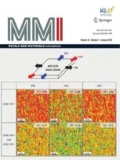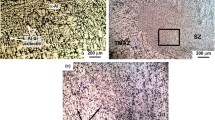Abstract
The goal of the present research is to introduce the Tungsten (W) nanoparticles as reinforcement into Al 6063 alloy to produce Al–W nanocomposites by the FSP technique. The vol% of the reinforcement was varied from 3 to 12 with a step of 3, besides the unreinforced Al matrix was considered as 0 vol% for comparison. The role of W nanoparticles in the Al 6063 matrix has been exhaustively investigated using advanced characterization techniques such as XRD analysis to observe the phases, FESEM to detect the distribution of reinforcements with their interparticle spacing and the average grain sizes, TEM analysis to study the strengthening factors, new phase formation at the interface between AA 6063 matrix and W particles, the morphology of the W nanoparticles. The achieved average matrix grains size was 42, 2, and 0.9 μm for 0, 6, and 12 vol% W nanocomposites, respectively. The obtained results disclosed the uniform dispersion of W nanoparticles, without any agglomeration, and with the absence of intermetallic compounds. The hardness and wear resistance of the fabricated nanocomposites were increased incommensurate with the incorporation of heavy metallic W element as reinforcement particle; which was due to the proper dispersion of W nanoparticles, refinement of matrix grains to ultrafine level, generation of dislocations, and clear interface between Al 6063 matrix and W nanoparticles. In a nutshell, AA 6063–12 vol% W nanocomposite has achieved the higher hardness (120 HV), lower wear rate (0.13 mm3/m), and friction coefficient (0.33) than other nanocomposites................The goal of the present research is to introduce the Tungsten (W) nanoparticles as reinforcement into Al 6063 alloy to produce Al–W nanocomposites by the FSP technique. The vol% of the reinforcement was varied from 3 to 12 with a step of 3, besides the unreinforced Al matrix was considered as 0 vol% for comparison. The role of W nanoparticles in the Al 6063 matrix has been exhaustively investigated using advanced characterization techniques such as XRD analysis to observe the phases, FESEM to detect the distribution of reinforcements with their interparticle spacing and the average grain sizes, TEM analysis to study the strengthening factors, new phase formation at the interface between AA 6063 matrix and W particles, the morphology of the W nanoparticles. The achieved average matrix grains size was 42, 2, and 0.9 μm for 0, 6, and 12 vol% W nanocomposites, respectively. The obtained results disclosed the uniform dispersion of W nanoparticles, without any agglomeration, and with the absence of intermetallic compounds. The hardness and wear resistance of the fabricated nanocomposites were increased incommensurate with the incorporation of heavy metallic W element as reinforcement particle; which was due to the proper dispersion of W nanoparticles, refinement of matrix grains to ultrafine level, generation of dislocations, and clear interface between Al 6063 matrix and W nanoparticles. In a nutshell, AA 6063–12 vol% W nanocomposite has achieved the higher hardness (120 HV), lower wear rate (0.13 mm3/m), and friction coefficient (0.33) than other nanocomposites.The goal of the present research is to introduce the Tungsten (W) nanoparticles as reinforcement into Al 6063 alloy to produce Al–W nanocomposites by the FSP technique. The vol% of the reinforcement was varied from 3 to 12 with a step of 3, besides the unreinforced Al matrix was considered as 0 vol% for comparison. The role of W nanoparticles in the Al 6063 matrix has been exhaustively investigated using advanced characterization techniques such as XRD analysis to observe the phases, FESEM to detect the distribution of reinforcements with their interparticle spacing and the average grain sizes, TEM analysis to study the strengthening factors, new phase formation at the interface between AA 6063 matrix and W particles, the morphology of the W nanoparticles. The achieved average matrix grains size was 42, 2, and 0.9 μm for 0, 6, and 12 vol% W nanocomposites, respectively. The obtained results disclosed the uniform dispersion of W nanoparticles, without any agglomeration, and with the absence of intermetallic compounds. The hardness and wear resistance of the fabricated nanocomposites were increased incommensurate with the incorporation of heavy metallic W element as reinforcement particle; which was due to the proper dispersion of W nanoparticles, refinement of matrix grains to ultrafine level, generation of dislocations, and clear interface between Al 6063 matrix and W nanoparticles. In a nutshell, AA 6063–12 vol% W nanocomposite has achieved the higher hardness (120 HV), lower wear rate (0.13 mm3/m), and friction coefficient (0.33) than other nanocomposites.
Graphic abstract











Similar content being viewed by others
Data Availability
The experimental datasets obtained from this research work and then the analysed results during the current study are available from the corresponding author on reasonable request.
Change history
10 August 2021
A Correction to this paper has been published: https://doi.org/10.1007/s12540-021-01068-6
Abbreviations
- AMCs:
-
Aluminium matrix composites
- AMNCs:
-
Aluminium matrix nanocomposites
- CDRX:
-
Continuous dynamic recrystallization
- COF:
-
Coefficient of Friction
- CTE:
-
Coefficient of thermal expansion
- DRV:
-
Dynamic recovery
- EBSD:
-
Electron Backscatter Diffraction
- EDAX:
-
Energy Dispersive X-ray Spectroscopy
- FSP:
-
Friction stir processing;
- GDRX:
-
Geometric dynamic recrystallization
- HAGB:
-
High angle grain boundaries
- IMCs:
-
Intermetallic compounds
- LAGB:
-
Low angle grain boundaries
- MMCs:
-
Metal matrix composites
- PSN:
-
Particle stimulated nucleation
- SEM:
-
Scanning electron microscopy
- SFE:
-
Stacking fault energy;
- TEM:
-
Transmission electron microscopy
- XRD:
-
X-ray diffraction analysis
References
M.-N. Avettand-Fenoel, A. Simar, Mater. Charact. 120, 1 (2016)
V.K.S. Jain, S. Muthukumaran, Metall. Mater. Trans. A 50, 2933 (2019)
Y. Alemdag, M. Beder, Met. Mater. Int. 26, 1811 (2020)
I. Dinaharan, R. Nelson, S.J. Vijay, E.T. Akinlabi, Mater. Charact. 118, 149 (2016)
R. Clinktan, V. Senthil, K.R. Ramkumar, S. Sivasankaran, F.A. Al-Mufadi, Ceram. Int. 45, 18691 (2019)
A. Heidarzadeh, S. Mironov, R. Kaibyshev, G. Cam, A. Simar, A. Gerlich, F. Khodabakhshi, A. Mostafaei, D.P. Field, J.D. Robson, A. Deschamps, P.J. Withers, Prog. Mater. Sci. 117, 100752 (2021)
X. Meng, Y. Huang, J. Cao, J. Shen, J.F. dos Santos, Prog. Mater. Sci. 115, 100706 (2021)
I. Dinaharan, S. Zhang, G. Chen, Q. Shi, Mater. Sci. Eng. A 772, 138793 (2020)
A. Ramakrishnan, G.P. Dinda, J. Alloy. Compd. 813, 152208 (2020)
H. Zhang, P. Feng, F. Akhtar, Sci. Rep. 7, 12391 (2017)
V. Sharma, U. Prakash, B.V.M. Kumar, J. Mater. Process. Tech. 224, 117 (2015)
I. Dinaharan, S. Saravana Kumar, K. Kalaiselvan, S. Gopalakrishnan, J. Asian Ceram. Soc. 5, 295 (2017)
Y. Mazaheri, M.M. Jalilvand, A. Heidarpour, A.R. Jahani, Tribol. Int. 143, 106062 (2019)
R. Bauri, D. Yadav, C.N.S. Kumar, B. Balaji, Mater. Sci. Eng. A 620, 67 (2015)
S. Ahmadifard, A. Momeni, S. Bahmanzadeh, S. Kazemi, Vacuum 155, 134 (2018)
G. Huang, Wu. Jie, W. Hou, Y. Shen, Mater. Sci. Eng. A 734, 353 (2018)
G. AzimiRoeen, S.F. Kashani-Bozorg, M. Nosko, S. Lotfian, Met. Mater. Int. 26, 1441(2020)
S. Selvakumar, I. Dinaharan, R. Palanivel, B. GaneshBabu, Mater. Charact. 125, 13 (2017)
A. Kumar, K. Pal, S. Mula, J. Manuf. Process. 30, 1 (2017)
G. Huang, Y. Shen, R. Guo, W. Guan, Mater. Sci. Eng. A 674, 504 (2016)
S. Saravanakumar, S. Gopalakrishnan, I. Dinaharan, K. Kalaiselvan, Surf. Coat. Tech. 322, 51 (2017)
S.J. Abraham, S.C.R. Madan, I. Dinaharan, L.J. Baruch, J. Asian Ceram. Soc. 4, 381 (2016)
K.R. Ramkumar, S. Sivasankaran, A.S. Alaboodi, J. Alloy. Compd. 709, 129 (2017)
C.N.S. Shyam Kumar, R. Bauri, D. Yadav, Tribol. Int. 101, 284 (2016)
G. Mirand, M. Buciumeanu, M.M. Costa, F. Bartolomeu, F.S. Silva, O. Carvalho, J. Compos. Mater. 51, 2805 (2017)
G. Miranda, M. Buciumeanu, O. Carvalho, D. Soares, F.S. Silva, Compos. Part B Eng. 69, 101 (2015)
C.Y. Liu, Q. Wang, Y.Z. Jia, B. Zhang, R. Jing, M.Z. Ma, Q. Jing, R.P. Liu, Mater. Sci. Eng. A 547, 120 (2012)
C.J. Hsu, P.W. Kao, N.J. Ho, Mater. Lett. 61, 1315 (2007)
C.J. Hsu, C.Y. Chang, P.W. Kao, N.J. Ho, C.P. Chang, Acta Mater. 54, 5241 (2006)
M. Alizadeh, M. Talebian, Mater. Sci. Eng. A 558, 331 (2012)
I.S. Lee, P.W. Kao, N.J. Ho, Intermetallics 16, 1104 (2008)
Author information
Authors and Affiliations
Contributions
LFA: Ph.D. scholar; Conducted the experiments and writing first draft; NKS: has guided for research and supported research facilities; RSN: Guided wear behaviour and analysed the data; KRR: Ideology, Materials selection, Design of experiments and Edited the first draft; SSK: Design of experiments and guided to analyse the characterization part, Data correction, examined the results, corrected the edited manuscript.
Corresponding author
Ethics declarations
Conflict of interest
The authors declare no conflict of interest.
Additional information
Publisher's Note
Springer Nature remains neutral with regard to jurisdictional claims in published maps and institutional affiliations.
The original online version of this article was revised due to the errors in third author's affiliation and figure 5. The affiliation and figure 5 have been corrected.
Rights and permissions
About this article
Cite this article
Ali, L.F., Kuppuswamy, N., Soundararajan, R. et al. Microstructural and Wear Behaviour of Al 6063–W Nanocomposites Developed Using Friction Stir Processing. Met. Mater. Int. 27, 5462–5473 (2021). https://doi.org/10.1007/s12540-021-01029-z
Received:
Accepted:
Published:
Issue Date:
DOI: https://doi.org/10.1007/s12540-021-01029-z




